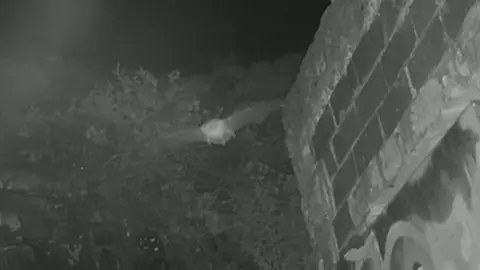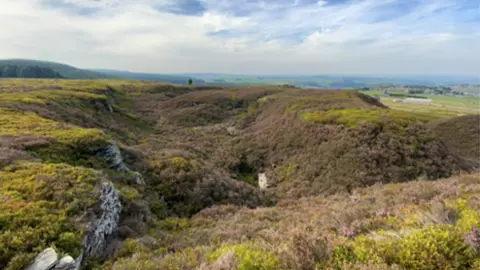Hayley Coyle
BBC News

Daubenton's Bats (similar to the one pictured above) are among the species found in the mines
Bats have turned a collection of abandoned coal mines into a prime mating spot, experts say.
Conservationists found eight species of bat using the mineshafts and surrounding moorland near Barnsley as an "autumn swarming" location.
Following a year-long study, the 28-hecatare site, which sits above a Yorkshire Water reservoir, has been granted Local Wildlife Status by Barnsley Council.
Sean Davey, lead ecologist for Yorkshire Water, said "autumn swarming" - where bats find a mate - was crucial for a healthy bat population.

Yorkshire Water
The bats' activity has been captured using night vision technology
The study, conducted by the South Yorkshire Bat Group and Yorkshire Water, included 24/7 acoustic monitoring and filming with night vision to monitor the bats' activity.
The team used special techniques to safely catch swarming bats, and were able to identify eight different species, including Natterer's, Daubenton's and Pipistrelle bats, using the area for breeding and feeding.
Mr Davey said: “Bat swarming sites are more commonly found in wooded lowland areas so it’s particularly interesting to find swarming happening up on this exposed moor with no trees around."
He explained that swarming sites are thought to have quite a large "catchment", with tiny bats flying "impressive distances" in order to swarm and find a mate.
Female bats only give birth to one offspring each year, so swarming in the autumn is "critical" for raising the next year’s generation of bats, he added.

The bats' activity has been captured using night vision technology
The study, conducted by the South Yorkshire Bat Group and Yorkshire Water, included 24/7 acoustic monitoring and filming with night vision to monitor the bats' activity.
The team used special techniques to safely catch swarming bats, and were able to identify eight different species, including Natterer's, Daubenton's and Pipistrelle bats, using the area for breeding and feeding.
Mr Davey said: “Bat swarming sites are more commonly found in wooded lowland areas so it’s particularly interesting to find swarming happening up on this exposed moor with no trees around."
He explained that swarming sites are thought to have quite a large "catchment", with tiny bats flying "impressive distances" in order to swarm and find a mate.
Female bats only give birth to one offspring each year, so swarming in the autumn is "critical" for raising the next year’s generation of bats, he added.

Yorkshire Water
Barnsley Council has now given the area the mines are in Local Wildlife Status
Robin Franklin, cabinet spokesperson for regeneration and culture, said: “It’s great to hear that we have protected species in our borough.
"Bats as a group provide an excellent indicator of the wider health of their eco-system; monitoring projects like this are therefore an important tool for conservationists."
Barnsley Council has now given the area the mines are in Local Wildlife Status
Robin Franklin, cabinet spokesperson for regeneration and culture, said: “It’s great to hear that we have protected species in our borough.
"Bats as a group provide an excellent indicator of the wider health of their eco-system; monitoring projects like this are therefore an important tool for conservationists."
No comments:
Post a Comment